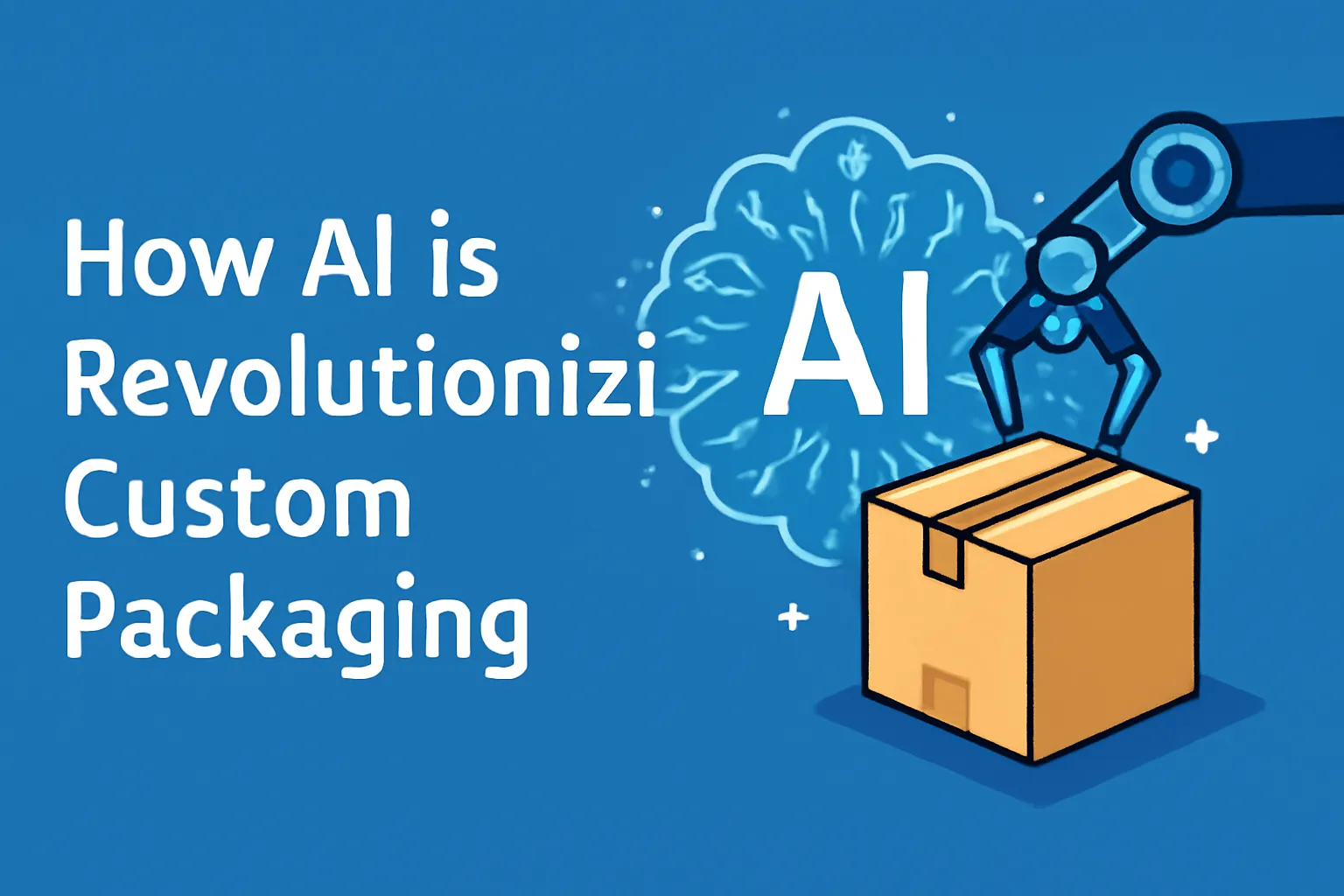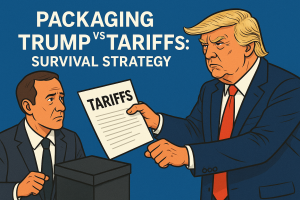Keeping pace with packaging demands for cost, sustainability, and appeal is challenging. Artificial intelligence offers tools to turn packaging into a strategic advantage. This article explores how AI reshapes design, materials, production, logistics, and personalization. We examine AI’s benefits, challenges, and how businesses can leverage it for smarter packaging, driving growth in a competitive market.
内容
隐藏
1. What Exactly is AI’s Role in Custom Packaging Today?
AI in packaging applies computer systems to tasks needing human intelligence, like pattern recognition and prediction, using algorithms to analyze data on materials, designs, supply chains, and production. The goal is smarter, faster, efficient, sustainable packaging. AI acts as an intelligent assistant, automating tasks and turning complex data into actionable improvements. But what does this look like in practice? Current applications include AI generating design variations rapidly, computer vision performing high-speed quality control, machine learning predicting machinery failures (predictive maintenance), and algorithms optimizing logistics like demand forecasting and route planning. Businesses adopt AI for efficiency gains, cost reduction through automation and waste minimization, enhanced sustainability via optimized designs and material selection, hyper-personalization to meet consumer expectations, and managing supply chain complexity. Adopting AI provides a significant competitive edge through smarter, more agile operations.
AI Applications in Packaging Lifecycle
|
Lifecycle Stage
|
AI Application Example
|
Benefit
|
|---|---|---|
|
Design
|
Generative Design Tools
|
Faster ideation, optimized structures
|
|
Material Selection
|
AI-Powered Material Database Analysis
|
Sustainable choices, cost savings
|
|
Production
|
Predictive Maintenance
|
Reduced downtime, lower repair costs
|
|
Quality Control
|
Computer Vision Inspection
|
Higher accuracy, fewer defects
|
|
Logistics
|
Demand Forecasting & Route Optimization
|
Lower inventory costs, reduced transport emissions
|
|
Personalization
|
Customer Data Analysis for Design
|
Enhanced customer engagement
|
2. How Does AI Enhance Packaging Design Processes?
AI revolutionizes design with generative tools that autonomously create numerous options based on input parameters (dimensions, materials, cost, aesthetics), drastically speeding up ideation. Think about the possibilities! This frees designers for strategic tasks. AI enables personalization at scale by analyzing customer data to tailor designs dynamically, integrating with digital printing for mass customization, turning packaging into a marketing tool. It optimizes structural designs for protection and material efficiency by simulating performance under shipping stresses, avoiding over or under-packaging. AI also facilitates virtual prototyping, allowing rapid digital testing (drop tests, compression) before physical mock-ups, accelerating development, reducing waste, and increasing confidence in the final design’s real-world performance.
3. Can AI Improve Material Selection for Packaging?
AI brings a data-driven approach to material selection, analyzing vast datasets on properties like strength, barrier performance, cost, and sustainability from diverse sources. It identifies correlations and predicts behavior, enabling informed choices beyond simple database lookups. But how does this translate into practical recommendations? AI helps navigate sustainability trade-offs by analyzing lifecycle assessment (LCA) data alongside performance and cost, recommending optimal eco-friendly and cost-effective materials (e.g., recycled content, bio-polymers). It enhances prediction of material durability under real-world conditions (temperature, humidity, transport vibration) using machine learning models trained on historical and sensor data, reducing failure risks. AI also accelerates sourcing of innovative materials by scanning research and patents, keeping companies ahead of the curve.
4. What Impact Does AI Have on Packaging Production Lines?
AI minimizes costly downtime through predictive maintenance (PdM). Sensors monitor machinery (vibration, temperature), and AI algorithms detect anomalies predicting failures before they occur, allowing proactive servicing. Here’s the deal: This optimizes maintenance and ensures smoother production. AI-powered computer vision automates quality control, using cameras and algorithms to inspect labels, seals, fill levels, and detect defects with superhuman speed and accuracy, reducing errors and waste. AI optimizes complex production schedules by analyzing orders, material availability, and machine uptime to maximize throughput and efficiency, dynamically adjusting to changes. It also enhances robotics, providing intelligence for complex tasks and enabling safer human-robot collaboration (cobots), leading to higher automation levels and flexibility.
5. How is AI Streamlining Packaging Logistics and Supply Chains?
AI significantly improves demand forecasting for packaging materials by analyzing historical sales plus external factors (trends, weather, economics), generating more accurate predictions than traditional methods. What’s the real story? This reduces stockouts and overstocking. Building on this, AI optimizes inventory management, determining ideal levels based on forecasts, lead times, and costs, often automating reordering. It optimizes warehouse layout for efficiency. AI algorithms solve complex vehicle routing problems, considering traffic, delivery windows, and vehicle capacity to minimize transport costs, fuel use, and emissions. AI also enhances real-time tracking and visibility by integrating data from various sources (sensors, carriers) and predicting potential delays, allowing proactive disruption management and improving overall supply chain resilience.
6. What are the Key AI Technologies Driving Packaging Innovation?
Machine Learning (ML) is fundamental, learning from data to make predictions for demand forecasting, predictive maintenance, material performance, and personalization. Essentially, ML turns data into actionable insights. Computer Vision enables machines to ‘see,’ primarily used for automated quality control (detecting defects, verifying labels) with high speed and accuracy, but also aiding design analysis. Natural Language Processing (NLP) allows computers to understand language, valuable for analyzing customer feedback from reviews or social media to identify packaging pain points and inform improvements. You might be wondering how this helps. Generative AI creates new content, revolutionizing early-stage design by producing novel visual concepts and structural ideas based on prompts, accelerating ideation and pushing creative boundaries.
7. How Does AI Enable Hyper-Personalized Packaging Experiences?
Hyper-personalization creates experiences tailored to individuals in real-time, driven by AI’s analysis of diverse customer data (transactional, demographic, behavioral). AI identifies patterns and predicts preferences for design or messaging. Ready for the good part? This deep understanding allows generative AI to create unique packaging designs (graphics, colors) reflecting individual profiles, delivering exclusivity at scale via digital printing. Personalization extends to integrating tailored messaging, offers, or QR codes linking to unique content onto packaging, based on AI analysis of customer data. This turns unboxing into an interactive, value-added touchpoint. Examples include targeted VDP campaigns or e-commerce shippers optimized and potentially containing personalized inserts based on AI-analyzed customer profiles.
8. What are the Sustainability Benefits of AI in Packaging?
AI optimizes material usage through structural design algorithms (lightweighting) and efficient cutting patterns (nesting), reducing resource consumption and costs. Think about the cumulative effect! It aids designing for recyclability and circularity by analyzing material compatibility with recycling infrastructure, flagging problematic combinations, and recommending mono-material or easy-to-separate designs. AI helps design for reuse systems and assess compostability. It improves energy efficiency in production by optimizing schedules and machinery parameters via predictive maintenance and real-time sensor analysis. AI also enables comprehensive tracking of environmental impact across the supply chain by integrating data (supplier reports, logistics, energy use), identifying hotspots, and supporting transparency for recycled content.
9. How Can AI Help Ensure Packaging Compliance and Safety?
AI automates navigating complex packaging regulations (food, pharma) by scanning specifications and designs against global standards (FDA, EFSA), flagging non-compliance issues early. But here’s the kicker… It can assist in generating required documentation. AI enhances monitoring of product integrity and tamper evidence using computer vision to inspect seals and closures on the line, and analyzing track-and-trace data to detect counterfeiting or diversion. It ensures labeling accuracy by having vision systems verify text, barcodes, dates, and warnings against master templates in real-time. For food/pharma, AI analyzes smart packaging sensor data (temperature, freshness), selects optimal barrier materials, ensures seal integrity, and provides robust traceability for safety and recall management.
10. What Challenges Arise When Implementing AI in Packaging?
Initial investment in software, hardware (sensors, cameras), and infrastructure can be significant, especially for SMBs. Calculating ROI can be complex, as benefits like improved design flexibility are hard to quantify. Here’s the reality check: Thorough feasibility studies and pilot projects are needed. Data privacy and security are major concerns when handling production, supply chain, or customer data; robust cybersecurity and compliance with regulations (GDPR) are essential. There’s a need for a skilled workforce (data scientists, AI engineers) and upskilling existing employees to manage and work alongside AI systems. Integrating new AI solutions with legacy IT systems (ERP, MES) can be technically challenging due to data silos and interoperability issues, requiring careful planning and often a phased approach.
11. How Can Small and Medium Businesses Leverage AI for Packaging?
AI is becoming more accessible to SMBs via scalable cloud platforms (AWS, Azure, Google Cloud) offering pay-as-you-go AI services, specialized SaaS solutions with user-friendly interfaces, and open-source libraries. What does this mean for you? Sophisticated tools are within reach. SMBs should start small, focusing on specific, high-impact applications with clear ROI, like automating quality control on one line or using an AI forecasting tool for key products, minimizing initial risk. Collaborating with external AI solution providers, consultants, or academic institutions provides access to expertise without large internal teams. Real-world SMB successes exist, such as using AI for demand forecasting, optimizing shipper box selection, or implementing targeted QC, proving viability through focused application.
12. What Does the Future Hold for AI in Custom Packaging?
Future generative design AI will likely handle complex multi-objective optimization (cost, sustainability, manufacturability) and generate highly innovative, context-aware concepts. Sounds like science fiction? Maybe, but the trend points there. Packaging lines will move towards fully autonomous (‘lights-out’) operations, with AI managing scheduling, robotics, quality control, and maintenance prescriptively. Tighter integration with IoT and smart packaging (embedded sensors) will provide real-time data on conditions like temperature or freshness, analyzed by AI for dynamic shelf-life prediction or quality assurance. AI will be instrumental in enabling effective circular economy models by optimizing reverse logistics, improving sorting of used packaging, and tracking materials through recycling processes.
13. How Does AI Impact the Cost-Effectiveness of Custom Packaging?
AI reduces design iteration time and costs through rapid concept generation and virtual prototyping, cutting down physical mock-ups and accelerating time-to-market. What’s the result? It minimizes material waste via structural optimization (lightweighting) and better nesting, directly cutting purchase costs. AI-driven quality control reduces scrap and rework, while predictive maintenance prevents costly downtime. AI optimizes logistics through accurate forecasting (reducing inventory costs) and efficient route planning (lowering transport expenses). While initial investment exists, the long-term ROI from cumulative savings across design, production, and logistics, plus strategic advantages like speed and sustainability, often makes AI a highly cost-effective investment for packaging operations.
14. What Skills Are Needed for Packaging Professionals in the AI Era?
Strong data analysis and interpretation skills are vital to understand insights from AI systems (dashboards, reports) and translate them into business actions. A conceptual understanding of AI tools (ML, computer vision) is needed to leverage them effectively, craft prompts, collaborate with experts, and troubleshoot issues. Why is this important? Enhanced collaboration skills across functions (design, production, IT) are crucial as AI breaks down silos and requires shared data and goals. Perhaps most critically, a mindset of continuous learning and adaptation is essential, given the rapid evolution of AI. Professionals must stay curious, experiment with new tools, and embrace change to remain relevant and drive innovation.
15. How Can Businesses Start Integrating AI into Their Packaging Strategy?
First, identify key pain points and strategic opportunities by assessing current operations – where are the inefficiencies, costs, or quality issues? Define specific problems AI could solve. This is crucial. Then, conduct pilot projects or proof-of-concepts (PoCs) by implementing a targeted AI solution on a limited scale to test feasibility, evaluate benefits, understand challenges, and build buy-in before large investments. Carefully choose the right AI partners and technologies based on pilot results and business needs, considering vendor expertise, support, security, and pricing. Finally, develop a phased implementation roadmap outlining deployment sequence, timelines, resources, and training needs, starting with high-ROI applications and adapting based on learnings.
Conclusion
Artificial intelligence is reshaping custom packaging into a strategic, data-driven field. It accelerates design, enables hyper-personalization, optimizes production, enhances sustainability, and streamlines supply chains. While challenges like cost and skill gaps exist, accessible tools and phased approaches make AI viable for all businesses. Embracing AI is key for cost reduction, quality improvement, meeting consumer demands, achieving sustainability, and gaining a competitive edge. The journey involves identifying needs and taking measured steps towards an AI-augmented future.
FAQ Section
Q1: What is AI-driven custom packaging? AI-driven custom packaging uses artificial intelligence technologies to optimize various stages of the packaging lifecycle, from design and material selection to production, logistics, and personalization, aiming for greater efficiency, sustainability, and customer engagement.
Q2: How does AI help reduce packaging waste? AI helps reduce waste by optimizing structural designs to use less material, improving production quality control to minimize rejects, enabling predictive maintenance to prevent line stoppages that cause waste, and assisting in selecting sustainable, recyclable materials more effectively.
Q3: Is AI packaging technology only for large corporations? While large corporations were early adopters, increasingly accessible AI tools (especially cloud-based SaaS solutions), specialized service providers, and scalable platforms are making AI-driven packaging solutions viable and beneficial for small and medium-sized businesses as well, particularly when starting with targeted pilot projects.
Q4: What is the difference between AI personalization and traditional customization? Traditional customization often involves selecting from predefined options (e.g., choosing a color or adding a name). AI personalization analyzes vast amounts of individual customer data to create truly unique, dynamically generated packaging designs, messages, or experiences tailored to specific preferences and behaviors at scale.
Q5: What are the first steps to implementing AI in our packaging process? Start by identifying specific challenges or strategic goals where AI could have the most impact (e.g., reducing design time, minimizing production defects, improving forecast accuracy). Then, research relevant AI tools or potential partners, conduct small, focused pilot projects to test feasibility and ROI, and develop a clear, phased implementation plan based on the results.




